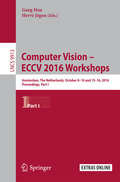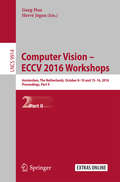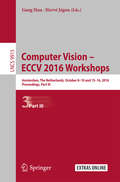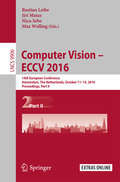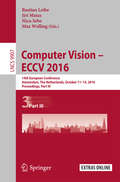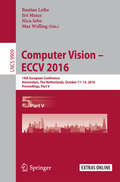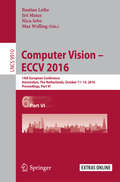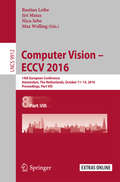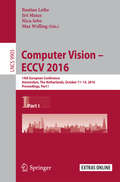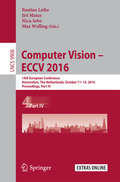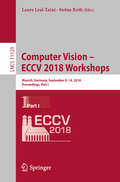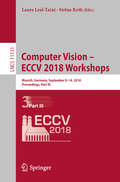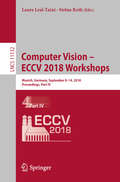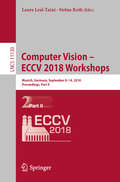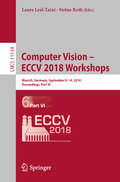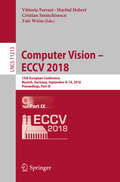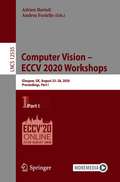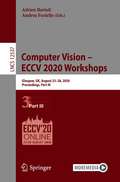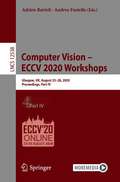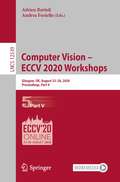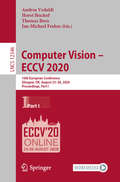- Table View
- List View
Computer Vision – ECCV 2016 Workshops: Amsterdam, The Netherlands, October 8-10 and 15-16, 2016, Proceedings, Part I (Lecture Notes in Computer Science #9913)
by Gang Hua Hervé JégouThe three-volume set LNCS 9913, LNCS 9914, and LNCS 9915 comprises the refereed proceedings of the Workshops that took place in conjunction with the 14th European Conference on Computer Vision, ECCV 2016, held in Amsterdam, The Netherlands, in October 2016. The three-volume set LNCS 9913, LNCS 9914, and LNCS 9915 comprises the refereed proceedings of the Workshops that took place in conjunction with the 14th European Conference on Computer Vision, ECCV 2016, held in Amsterdam, The Netherlands, in October 2016. 27 workshops from 44 workshops proposals were selected for inclusion in the proceedings. These address the following themes: Datasets and Performance Analysis in Early Vision; Visual Analysis of Sketches; Biological and Artificial Vision; Brave New Ideas for Motion Representations; Joint ImageNet and MS COCO Visual Recognition Challenge; Geometry Meets Deep Learning; Action and Anticipation for Visual Learning; Computer Vision for Road Scene Understanding and Autonomous Driving; Challenge on Automatic Personality Analysis; BioImage Computing; Benchmarking Multi-Target Tracking: MOTChallenge; Assistive Computer Vision and Robotics; Transferring and Adapting Source Knowledge in Computer Vision; Recovering 6D Object Pose; Robust Reading; 3D Face Alignment in the Wild and Challenge; Egocentric Perception, Interaction and Computing; Local Features: State of the Art, Open Problems and Performance Evaluation; Crowd Understanding; Video Segmentation; The Visual Object Tracking Challenge Workshop; Web-scale Vision and Social Media; Computer Vision for Audio-visual Media; Computer VISion for ART Analysis; Virtual/Augmented Reality for Visual Artificial Intelligence; Joint Workshop on Storytelling with Images and Videos and Large Scale Movie Description and Understanding Challenge.
Computer Vision – ECCV 2016 Workshops: Amsterdam, The Netherlands, October 8-10 and 15-16, 2016, Proceedings, Part II (Lecture Notes in Computer Science #9914)
by Gang Hua Hervé JégouThe three-volume set LNCS 9913, LNCS 9914, and LNCS 9915 comprises the refereed proceedings of the Workshops that took place in conjunction with the 14th European Conference on Computer Vision, ECCV 2016, held in Amsterdam, The Netherlands, in October 2016. The three-volume set LNCS 9913, LNCS 9914, and LNCS 9915 comprises the refereed proceedings of the Workshops that took place in conjunction with the 14th European Conference on Computer Vision, ECCV 2016, held in Amsterdam, The Netherlands, in October 2016. 27 workshops from 44 workshops proposals were selected for inclusion in the proceedings. These address the following themes: Datasets and Performance Analysis in Early Vision; Visual Analysis of Sketches; Biological and Artificial Vision; Brave New Ideas for Motion Representations; Joint ImageNet and MS COCO Visual Recognition Challenge; Geometry Meets Deep Learning; Action and Anticipation for Visual Learning; Computer Vision for Road Scene Understanding and Autonomous Driving; Challenge on Automatic Personality Analysis; BioImage Computing; Benchmarking Multi-Target Tracking: MOTChallenge; Assistive Computer Vision and Robotics; Transferring and Adapting Source Knowledge in Computer Vision; Recovering 6D Object Pose; Robust Reading; 3D Face Alignment in the Wild and Challenge; Egocentric Perception, Interaction and Computing; Local Features: State of the Art, Open Problems and Performance Evaluation; Crowd Understanding; Video Segmentation; The Visual Object Tracking Challenge Workshop; Web-scale Vision and Social Media; Computer Vision for Audio-visual Media; Computer VISion for ART Analysis; Virtual/Augmented Reality for Visual Artificial Intelligence; Joint Workshop on Storytelling with Images and Videos and Large Scale Movie Description and Understanding Challenge.
Computer Vision – ECCV 2016 Workshops: Amsterdam, The Netherlands, October 8-10 and 15-16, 2016, Proceedings, Part III (Lecture Notes in Computer Science #9915)
by Gang Hua Hervé JégouThe three-volume set LNCS 9913, LNCS 9914, and LNCS 9915 comprises the refereed proceedings of the Workshops that took place in conjunction with the 14th European Conference on Computer Vision, ECCV 2016, held in Amsterdam, The Netherlands, in October 2016. The three-volume set LNCS 9913, LNCS 9914, and LNCS 9915 comprises the refereed proceedings of the Workshops that took place in conjunction with the 14th European Conference on Computer Vision, ECCV 2016, held in Amsterdam, The Netherlands, in October 2016. 27 workshops from 44 workshops proposals were selected for inclusion in the proceedings. These address the following themes: Datasets and Performance Analysis in Early Vision; Visual Analysis of Sketches; Biological and Artificial Vision; Brave New Ideas for Motion Representations; Joint ImageNet and MS COCO Visual Recognition Challenge; Geometry Meets Deep Learning; Action and Anticipation for Visual Learning; Computer Vision for Road Scene Understanding and Autonomous Driving; Challenge on Automatic Personality Analysis; BioImage Computing; Benchmarking Multi-Target Tracking: MOTChallenge; Assistive Computer Vision and Robotics; Transferring and Adapting Source Knowledge in Computer Vision; Recovering 6D Object Pose; Robust Reading; 3D Face Alignment in the Wild and Challenge; Egocentric Perception, Interaction and Computing; Local Features: State of the Art, Open Problems and Performance Evaluation; Crowd Understanding; Video Segmentation; The Visual Object Tracking Challenge Workshop; Web-scale Vision and Social Media; Computer Vision for Audio-visual Media; Computer VISion for ART Analysis; Virtual/Augmented Reality for Visual Artificial Intelligence; Joint Workshop on Storytelling with Images and Videos and Large Scale Movie Description and Understanding Challenge.
Computer Vision – ECCV 2016: 14th European Conference, Amsterdam, The Netherlands, October 11-14, 2016, Proceedings, Part II (Lecture Notes in Computer Science #9906)
by Nicu Sebe Bastian Leibe Jiri Matas Max WellingThe eight-volume set comprising LNCS volumes 9905-9912 constitutes the refereed proceedings of the 14th European Conference on Computer Vision, ECCV 2016, held in Amsterdam, The Netherlands, in October 2016. The 415 revised papers presented were carefully reviewed and selected from 1480 submissions. The papers cover all aspects of computer vision and pattern recognition such as 3D computer vision; computational photography, sensing and display; face and gesture; low-level vision and image processing; motion and tracking; optimization methods; physics-based vision, photometry and shape-from-X; recognition: detection, categorization, indexing, matching; segmentation, grouping and shape representation; statistical methods and learning; video: events, activities and surveillance; applications. They are organized in topical sections on detection, recognition and retrieval; scene understanding; optimization; image and video processing; learning; action, activity and tracking; 3D; and 9 poster sessions.
Computer Vision – ECCV 2016: 14th European Conference, Amsterdam, The Netherlands, October 11-14, 2016, Proceedings, Part III (Lecture Notes in Computer Science #9907)
by Nicu Sebe Bastian Leibe Jiri Matas Max WellingThe eight-volume set comprising LNCS volumes 9905-9912 constitutes the refereed proceedings of the 14th European Conference on Computer Vision, ECCV 2016, held in Amsterdam, The Netherlands, in October 2016. The 415 revised papers presented were carefully reviewed and selected from 1480 submissions. The papers cover all aspects of computer vision and pattern recognition such as 3D computer vision; computational photography, sensing and display; face and gesture; low-level vision and image processing; motion and tracking; optimization methods; physics-based vision, photometry and shape-from-X; recognition: detection, categorization, indexing, matching; segmentation, grouping and shape representation; statistical methods and learning; video: events, activities and surveillance; applications. They are organized in topical sections on detection, recognition and retrieval; scene understanding; optimization; image and video processing; learning; action, activity and tracking; 3D; and 9 poster sessions.
Computer Vision – ECCV 2016: 14th European Conference, Amsterdam, The Netherlands, October 11-14, 2016, Proceedings, Part V (Lecture Notes in Computer Science #9909)
by Nicu Sebe Bastian Leibe Jiri Matas Max WellingThe eight-volume set comprising LNCS volumes 9905-9912 constitutes the refereed proceedings of the 14th European Conference on Computer Vision, ECCV 2016, held in Amsterdam, The Netherlands, in October 2016. The 415 revised papers presented were carefully reviewed and selected from 1480 submissions. The papers cover all aspects of computer vision and pattern recognition such as 3D computer vision; computational photography, sensing and display; face and gesture; low-level vision and image processing; motion and tracking; optimization methods; physics-based vision, photometry and shape-from-X; recognition: detection, categorization, indexing, matching; segmentation, grouping and shape representation; statistical methods and learning; video: events, activities and surveillance; applications. They are organized in topical sections on detection, recognition and retrieval; scene understanding; optimization; image and video processing; learning; action, activity and tracking; 3D; and 9 poster sessions.
Computer Vision – ECCV 2016: 14th European Conference, Amsterdam, The Netherlands, October 11-14, 2016, Proceedings, Part VI (Lecture Notes in Computer Science #9910)
by Nicu Sebe Bastian Leibe Jiri Matas Max WellingThe eight-volume set comprising LNCS volumes 9905-9912 constitutes the refereed proceedings of the 14th European Conference on Computer Vision, ECCV 2016, held in Amsterdam, The Netherlands, in October 2016. The 415 revised papers presented were carefully reviewed and selected from 1480 submissions. The papers cover all aspects of computer vision and pattern recognition such as 3D computer vision; computational photography, sensing and display; face and gesture; low-level vision and image processing; motion and tracking; optimization methods; physics-based vision, photometry and shape-from-X; recognition: detection, categorization, indexing, matching; segmentation, grouping and shape representation; statistical methods and learning; video: events, activities and surveillance; applications. They are organized in topical sections on detection, recognition and retrieval; scene understanding; optimization; image and video processing; learning; action, activity and tracking; 3D; and 9 poster sessions.
Computer Vision – ECCV 2016: 14th European Conference, Amsterdam, The Netherlands, October 11-14, 2016, Proceedings, Part VIII (Lecture Notes in Computer Science #9912)
by Nicu Sebe Bastian Leibe Jiri Matas Max WellingThe eight-volume set comprising LNCS volumes 9905-9912 constitutes the refereed proceedings of the 14th European Conference on Computer Vision, ECCV 2016, held in Amsterdam, The Netherlands, in October 2016. The 415 revised papers presented were carefully reviewed and selected from 1480 submissions. The papers cover all aspects of computer vision and pattern recognition such as 3D computer vision; computational photography, sensing and display; face and gesture; low-level vision and image processing; motion and tracking; optimization methods; physics-based vision, photometry and shape-from-X; recognition: detection, categorization, indexing, matching; segmentation, grouping and shape representation; statistical methods and learning; video: events, activities and surveillance; applications. They are organized in topical sections on detection, recognition and retrieval; scene understanding; optimization; image and video processing; learning; action, activity and tracking; 3D; and 9 poster sessions.
Computer Vision – ECCV 2016: 14th European Conference, Amsterdam, The Netherlands, October 11–14, 2016, Proceedings, Part I (Lecture Notes in Computer Science #9905)
by Nicu Sebe Bastian Leibe Jiri Matas Max WellingThe eight-volume set comprising LNCS volumes 9905-9912 constitutes the refereed proceedings of the 14th European Conference on Computer Vision, ECCV 2016, held in Amsterdam, The Netherlands, in October 2016. The 415 revised papers presented were carefully reviewed and selected from 1480 submissions. The papers cover all aspects of computer vision and pattern recognition such as 3D computer vision; computational photography, sensing and display; face and gesture; low-level vision and image processing; motion and tracking; optimization methods; physics-based vision, photometry and shape-from-X; recognition: detection, categorization, indexing, matching; segmentation, grouping and shape representation; statistical methods and learning; video: events, activities and surveillance; applications. They are organized in topical sections on detection, recognition and retrieval; scene understanding; optimization; image and video processing; learning; action, activity and tracking; 3D; and 9 poster sessions.
Computer Vision – ECCV 2016: 14th European Conference, Amsterdam, The Netherlands, October 11–14, 2016, Proceedings, Part IV (Lecture Notes in Computer Science #9908)
by Nicu Sebe Bastian Leibe Jiri Matas Max WellingThe eight-volume set comprising LNCS volumes 9905-9912 constitutes the refereed proceedings of the 14th European Conference on Computer Vision, ECCV 2016, held in Amsterdam, The Netherlands, in October 2016. The 415 revised papers presented were carefully reviewed and selected from 1480 submissions. The papers cover all aspects of computer vision and pattern recognition such as 3D computer vision; computational photography, sensing and display; face and gesture; low-level vision and image processing; motion and tracking; optimization methods; physics-based vision, photometry and shape-from-X; recognition: detection, categorization, indexing, matching; segmentation, grouping and shape representation; statistical methods and learning; video: events, activities and surveillance; applications. They are organized in topical sections on detection, recognition and retrieval; scene understanding; optimization; image and video processing; learning; action, activity and tracking; 3D; and 9 poster sessions.
Computer Vision – ECCV 2016: 14th European Conference, Amsterdam, The Netherlands, October 11–14, 2016, Proceedings, Part VII (Lecture Notes in Computer Science #9911)
by Nicu Sebe Bastian Leibe Jiri Matas Max WellingThe eight-volume set comprising LNCS volumes 9905-9912 constitutes the refereed proceedings of the 14th European Conference on Computer Vision, ECCV 2016, held in Amsterdam, The Netherlands, in October 2016. The 415 revised papers presented were carefully reviewed and selected from 1480 submissions. The papers cover all aspects of computer vision and pattern recognition such as 3D computer vision; computational photography, sensing and display; face and gesture; low-level vision and image processing; motion and tracking; optimization methods; physics-based vision, photometry and shape-from-X; recognition: detection, categorization, indexing, matching; segmentation, grouping and shape representation; statistical methods and learning; video: events, activities and surveillance; applications. They are organized in topical sections on detection, recognition and retrieval; scene understanding; optimization; image and video processing; learning; action, activity and tracking; 3D; and 9 poster sessions.
Computer Vision – ECCV 2018 Workshops: Munich, Germany, September 8-14, 2018, Proceedings, Part I (Lecture Notes in Computer Science #11129)
by Stefan Roth Laura Leal-TaixéThe six-volume set comprising the LNCS volumes 11129-11134 constitutes the refereed proceedings of the workshops that took place in conjunction with the 15th European Conference on Computer Vision, ECCV 2018, held in Munich, Germany, in September 2018.43 workshops from 74 workshops proposals were selected for inclusion in the proceedings. The workshop topics present a good orchestration of new trends and traditional issues, built bridges into neighboring fields, and discuss fundamental technologies and novel applications.
Computer Vision – ECCV 2018 Workshops: Munich, Germany, September 8-14, 2018, Proceedings, Part I (Lecture Notes in Computer Science #11129)
by Stefan Roth Laura Leal-TaixéThe six-volume set comprising the LNCS volumes 11129-11134 constitutes the refereed proceedings of the workshops that took place in conjunction with the 15th European Conference on Computer Vision, ECCV 2018, held in Munich, Germany, in September 2018.43 workshops from 74 workshops proposals were selected for inclusion in the proceedings. The workshop topics present a good orchestration of new trends and traditional issues, built bridges into neighboring fields, and discuss fundamental technologies and novel applications.
Computer Vision – ECCV 2018 Workshops: Munich, Germany, September 8-14, 2018, Proceedings, Part I (Lecture Notes in Computer Science #11129)
by Stefan Roth Laura Leal-TaixéThe six-volume set comprising the LNCS volumes 11129-11134 constitutes the refereed proceedings of the workshops that took place in conjunction with the 15th European Conference on Computer Vision, ECCV 2018, held in Munich, Germany, in September 2018.43 workshops from 74 workshops proposals were selected for inclusion in the proceedings. The workshop topics present a good orchestration of new trends and traditional issues, built bridges into neighboring fields, and discuss fundamental technologies and novel applications.
Computer Vision – ECCV 2018 Workshops: Munich, Germany, September 8-14, 2018, Proceedings, Part II (Lecture Notes in Computer Science #11130)
by Stefan Roth Laura Leal-TaixéThe six-volume set comprising the LNCS volumes 11129-11134 constitutes the refereed proceedings of the workshops that took place in conjunction with the 15th European Conference on Computer Vision, ECCV 2018, held in Munich, Germany, in September 2018. 43 workshops from 74 workshops proposals were selected for inclusion in the proceedings. The workshop topics present a good orchestration of new trends and traditional issues, built bridges into neighboring fields, and discuss fundamental technologies and novel applications.
Computer Vision – ECCV 2018 Workshops: Munich, Germany, September 8-14, 2018, Proceedings, Part VI (Lecture Notes in Computer Science #11134)
by Stefan Roth Laura Leal-TaixéThe six-volume set comprising the LNCS volumes 11129-11134 constitutes the refereed proceedings of the workshops that took place in conjunction with the 15th European Conference on Computer Vision, ECCV 2018, held in Munich, Germany, in September 2018.43 workshops from 74 workshops proposals were selected for inclusion in the proceedings. The workshop topics present a good orchestration of new trends and traditional issues, built bridges into neighboring fields, and discuss fundamental technologies and novel applications.
Computer Vision – ECCV 2018: 15th European Conference, Munich, Germany, September 8–14, 2018, Proceedings, Part IX (Lecture Notes in Computer Science #11213)
by Vittorio Ferrari Martial Hebert Cristian Sminchisescu Yair WeissThe sixteen-volume set comprising the LNCS volumes 11205-11220 constitutes the refereed proceedings of the 15th European Conference on Computer Vision, ECCV 2018, held in Munich, Germany, in September 2018.The 776 revised papers presented were carefully reviewed and selected from 2439 submissions. The papers are organized in topical sections on learning for vision; computational photography; human analysis; human sensing; stereo and reconstruction; optimization; matching and recognition; video attention; and poster sessions.
Computer Vision – ECCV 2018: 15th European Conference, Munich, Germany, September 8–14, 2018, Proceedings, Part V (Lecture Notes in Computer Science #11209)
by Vittorio Ferrari Martial Hebert Cristian Sminchisescu Yair WeissThe sixteen-volume set comprising the LNCS volumes 11205-11220 constitutes the refereed proceedings of the 15th European Conference on Computer Vision, ECCV 2018, held in Munich, Germany, in September 2018.The 776 revised papers presented were carefully reviewed and selected from 2439 submissions. The papers are organized in topical sections on learning for vision; computational photography; human analysis; human sensing; stereo and reconstruction; optimization; matching and recognition; video attention; and poster sessions.
Computer Vision – ECCV 2020 Workshops: Glasgow, UK, August 23–28, 2020, Proceedings, Part I (Lecture Notes in Computer Science #12535)
by Andrea Fusiello Adrien BartoliThe 6-volume set, comprising the LNCS books 12535 until 12540, constitutes the refereed proceedings of 28 out of the 45 workshops held at the 16th European Conference on Computer Vision, ECCV 2020. The conference was planned to take place in Glasgow, UK, during August 23-28, 2020, but changed to a virtual format due to the COVID-19 pandemic. The 249 full papers, 18 short papers, and 21 further contributions included in the workshop proceedings were carefully reviewed and selected from a total of 467 submissions. The papers deal with diverse computer vision topics. Part I focusses on adversarial robustness in the real world; bioimage computation; egocentric perception, interaction and computing; eye gaze in VR, AR, and in the wild; TASK-CV workshop and VisDA challenge; and bodily expressed emotion understanding.
Computer Vision – ECCV 2020 Workshops: Glasgow, UK, August 23–28, 2020, Proceedings, Part II (Lecture Notes in Computer Science #12536)
by Andrea Fusiello Adrien BartoliThe 5-volume set, comprising the LNCS books 12535 until 12540, constitutes the refereed proceedings of 28 out of the 45 workshops held at the 16th European Conference on Computer Vision, ECCV 2020. The conference was planned to take place in Glasgow, UK, during August 23-28, 2020, but changed to a virtual format due to the COVID-19 pandemic.The 249 full papers, 18 short papers, and 21 further contributions included in the workshop proceedings were carefully reviewed and selected from a total of 467 submissions. The papers deal with diverse computer vision topics. Part II focusses on commands for autonomous vehicles; computer vision for ART analysis; sign language recognition, translation and production; visual inductive priors for data-efficient deep learning; 3D poses in the wild challenge; map-based localization for autonomous driving; recovering 6D object pose; and shape recovery from partial textured 3D scans.
Computer Vision – ECCV 2020 Workshops: Glasgow, UK, August 23–28, 2020, Proceedings, Part III (Lecture Notes in Computer Science #12537)
by Andrea Fusiello Adrien BartoliThe 6-volume set, comprising the LNCS books 12535 until 12540, constitutes the refereed proceedings of 28 out of the 45 workshops held at the 16th European Conference on Computer Vision, ECCV 2020. The conference was planned to take place in Glasgow, UK, during August 23-28, 2020, but changed to a virtual format due to the COVID-19 pandemic.The 249 full papers, 18 short papers, and 21 further contributions included in the workshop proceedings were carefully reviewed and selected from a total of 467 submissions. The papers deal with diverse computer vision topics.Part III includes the Advances in Image Manipulation Workshop and Challenges.
Computer Vision – ECCV 2020 Workshops: Glasgow, UK, August 23–28, 2020, Proceedings, Part IV (Lecture Notes in Computer Science #12538)
by Andrea Fusiello Adrien BartoliThe 5-volume set, comprising the LNCS books 12535 until 12540, constitutes the refereed proceedings of 28 out of the 45 workshops held at the 16th European Conference on Computer Vision, ECCV 2020. The conference was planned to take place in Glasgow, UK, during August 23-28, 2020, but changed to a virtual format due to the COVID-19 pandemic.The 249 full papers, 18 short papers, and 21 further contributions included in the workshop proceedings were carefully reviewed and selected from a total of 467 submissions. The papers deal with diverse computer vision topics.Part IV focusses on advances in image manipulation; assistive computer vision and robotics; and computer vision for UAVs.
Computer Vision – ECCV 2020 Workshops: Glasgow, UK, August 23–28, 2020, Proceedings, Part V (Lecture Notes in Computer Science #12539)
by Andrea Fusiello Adrien BartoliThe 6-volume set, comprising the LNCS books 12535 until 12540, constitutes the refereed proceedings of 28 out of the 45 workshops held at the 16th European Conference on Computer Vision, ECCV 2020. The conference was planned to take place in Glasgow, UK, during August 23-28, 2020, but changed to a virtual format due to the COVID-19 pandemic.The 249 full papers, 18 short papers, and 21 further contributions included in the workshop proceedings were carefully reviewed and selected from a total of 467 submissions. The papers deal with diverse computer vision topics.Part V includes: The 16th Embedded Vision Workshop; Real-World Computer Vision from Inputs with Limited Quality (RLQ); The Bright and Dark Sides of Computer Vision: Challenges and Opportunities for Privacy and Security (CV-COPS 2020); The Visual Object Tracking Challenge Workshop (VOT 2020); and Video Turing Test: Toward Human-Level Video Story Understanding.
Computer Vision – ECCV 2020 Workshops: Glasgow, UK, August 23–28, 2020, Proceedings, Part VI (Lecture Notes in Computer Science #12540)
by Andrea Fusiello Adrien BartoliThe 6-volume set, comprising the LNCS books 12535 until 12540, constitutes the refereed proceedings of 28 out of the 45 workshops held at the 16th European Conference on Computer Vision, ECCV 2020. The conference was planned to take place in Glasgow, UK, during August 23-28, 2020, but changed to a virtual format due to the COVID-19 pandemic.The 249 full papers, 18 short papers, and 21 further contributions included in the workshop proceedings were carefully reviewed and selected from a total of 467 submissions. The papers deal with diverse computer vision topics. Part VI focusses on reassessing the evaluation of object detection; computer vision problems in plant phenotyping; fair face recognition and analysis; and perception through structured generative models.
Computer Vision – ECCV 2020: 16th European Conference, Glasgow, UK, August 23–28, 2020, Proceedings, Part I (Lecture Notes in Computer Science #12346)
by Thomas Brox Andrea Vedaldi Horst Bischof Jan-Michael FrahmThe 30-volume set, comprising the LNCS books 12346 until 12375, constitutes the refereed proceedings of the 16th European Conference on Computer Vision, ECCV 2020, which was planned to be held in Glasgow, UK, during August 23-28, 2020. The conference was held virtually due to the COVID-19 pandemic.The 1360 revised papers presented in these proceedings were carefully reviewed and selected from a total of 5025 submissions. The papers deal with topics such as computer vision; machine learning; deep neural networks; reinforcement learning; object recognition; image classification; image processing; object detection; semantic segmentation; human pose estimation; 3d reconstruction; stereo vision; computational photography; neural networks; image coding; image reconstruction; object recognition; motion estimation.
